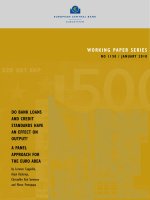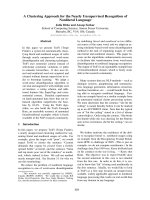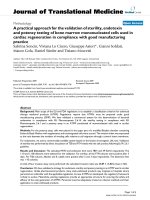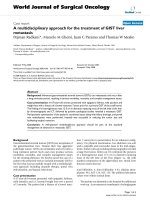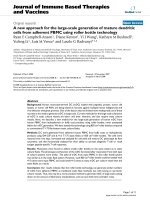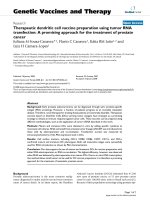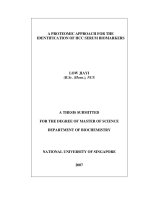A guidance approach for the encouraging classroom 6th edition dan gartrell test bank
Bạn đang xem bản rút gọn của tài liệu. Xem và tải ngay bản đầy đủ của tài liệu tại đây (123.57 KB, 3 trang )
Chapter 2: Child Development and Guidance
MULTIPLE CHOICE
1. Who was responsible for bringing developmental theory of children to the forefront of
psychology in the 20th century?
a. Maria Montessori
b. Howard Gardner
c. Jean Piaget
d. Lev Vygotsky
ANS: C
PTS: 1
2. The self-talk that children engage in during play is known as
a. zone of proximanl development
b. the problem of the match
c. separation anxiety
d. private speech
ANS: D
PTS: 1
3. Which of the following is NOT one of the stages Piaget identifies in his developmental
theory?
a. sensorimotor
b. disequilibrium
c. concrete operations
d. formal operations
ANS: B
PTS: 1
4. Which of the following did Vygotsky identify in children as the distance between the actual
developmental level determined by problem solving and the potential development?
a. autonomy
b. private speech
c. separation anxiety
d. zone of proximal development
ANS: D
PTS: 1
5. Identify which of the following is NOT a stage of development in Erikson’s developmental
theory.
a. initative versus guilt
b. trust versus mistrust
c. autonomy versus shame and doubt
d. disequilibrium
ANS: D
PTS: 1
6. Which of the following is one of the intelligences identified by Howard Gardner in his theory
of multiple intelligences?
a. linguistic
b. equilibrium
c. emotional intelligence
d. developmental egocentrism
ANS: A
PTS: 1
7. Which of the following is NOT an area that Vygotsky and Piaget are in agreement upon?
a. cognitive and social-emotional development happening together and overlapping
b. learning that results from a child’s interaction with the physical and social
environment
c. the role of private or egocentric speech in learning
d. cooperative, interactive teacher-child interactions define the best environment for
learning by the child
ANS: C
PTS: 1
8. Which of the following has supported the use of standardized assessments as a means of
enforcing educational accountability?
a. modern developmental psychology
b. the “No Child Left Behind” law
c. child welfare agencies
d. local school districts
ANS: A
PTS: 1
9. As a result of brain research, we now know which of the following?
a. intelligence is not fixed at birth
b. intelligence is fixed at birth
c. Economic conditions of the family factor into the intelligence of the child’s
development
d. Social class influences the intelligence of children.
ANS: A
PTS: 1
10. Which of the following is one of the five components of emotional intelligence?
a. physiological well-being
b. knowing one’s emotions
c. scaffolding
d. equilibrium
ANS: B
PTS: 1
11. Before children grow into Piaget’s “concrete operations” stage, their social understanding
a. is limited
b. is based on prior experience
c. reflects understanding of the dynamics of the situation
d. grows from competitive experiences
ANS: A
PTS: 1
12. According to Vygotsky, as children develop,
a. scaffolding by peers has limited effect on their development
b. learning activities should be focused on teacher-child interactions
c. their private speech evolves into a mechanism for building self-control.
d. scaffolding is an easy interaction to develop with young children
ANS: C
PTS: 1
13. Erik Erikson believed that healthy personal development
a. develops only in enriched environments
b. comes from the resolution of universal inner conflicts
c. results from the complete resolution of unmet
d. comes from narrowing the focus of experiences and self initiative
ANS: B
PTS: 1
14. According to Brazelton and Greenspan, the important factor in the child’s development is
a. the difference in the quality of nonparental caregiving
b. the limitations of nonparental caregiving in early childhood settings
c. the importance of the role of the child’s caregiver in early childhood settings
d. the minimal effects of the family-educator partnership
ANS: C
PTS: 1
ESSAY
1. Why is guidance important for healthy development in a diverse society?
ANS:
Going beyond the generalities associated with ethnic groups, each family has its own
microculture comprised of the family’s particular traditions, values, religious practices,
work-orientations, social expectations, and inter-personal dynamics. Teachers who use
guidance recognize that the child is the extension of the family unit and build partnerships
with families to bridge cultural differences between home and classroom. Children who see
evidence of their family’s microcultures in the educational program and perceive harmony in
relations between family and the teacher see the world as a trustworthy place and are more
able to learn democratic life skills.
PTS: 1
2. How does the teacher create a climate for partnerships with families?
ANS:
Before and during the first days of school, the teacher does much to create a climate for
partnerships with family members through the use of notes, telephone calls, home visits, and
greeting meetings. Initiating partnerships eases the transition of the child from home to
school. If parents know the teacher is working to build positive relations with both the child
and themselves, they are more likely to become involved. Teachers cannot expect to feel
positively toward every family member, but by remaining friendly and accessible, most
family members will respond. Family involvement in the education program can make a
lifelong difference to the child and the family.
PTS: 1

